With the weather dropping below 80 degrees and the arrival of fall, baking season is officially upon us. The cooler weather and abundance of seasonal produce make it all the more appealing to turn on the oven. If you’re anything like me, this season is the time for apple crisp, pumpkin bread, ginger cookies, and of course, The Great British Bake Off. But, what’s the chemistry behind the ingredients we’re mixing and how do they come together to create such delicious desserts?
Flour

Flour is composed of starch granules and proteins, the latter of which cause the stickiness and elasticity of dough. When mixed in water, these proteins, glutenin and gliadin, crosslink through intermolecular disulfide bonds to form a gluten network. When dough rises and gases (i.e. carbon dioxide formed from yeast fermentation) expand, this network stretches. However, the mixing time and amount of protein affect the gluten network’s strength and thus its ability to expand. If the gluten network bonds are too strong, the dough won’t rise, whereas if the network is too weak, the dough won’t stay risen. Therefore, breads and biscuits tend to use bread flour, which contains a higher protein content, whereas pastries and cakes use flour with a smaller protein content.
Water
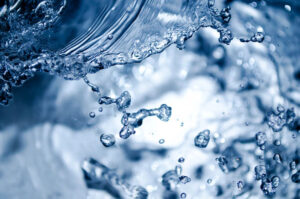
Water, either added on its own or from wet ingredients, is an integral part of baking. It keeps dough moist and serves as a solvent that allows chemical reactions to occur between other ingredients. Additionally, during baking water vaporizes to steam which expands and contributes to the rise of pastry dough.
Fat
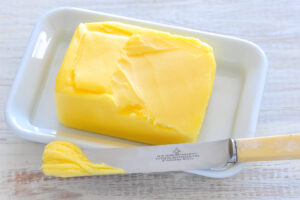
There are many different sources of fat that can be used for baking. Butter, vegetable shortening, oils, and lard are all hydrophobic hydrocarbons. When fats coat flour, they repel water that would otherwise activate glutenin and gliadin to form gluten, which slows or “shortens” gluten formation, hence the name “shortening.” Less gluten means softer and more tender, crumbly products; this is why cakes tend to contain more butter than breads.
Leavening Agents
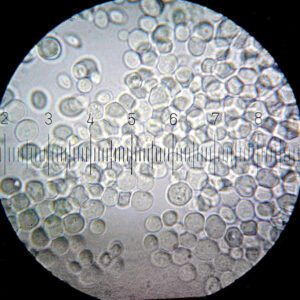
Leavening agents make dough rise. Examples include yeast, baking soda, and steam. All of these leavening agents form gases that expand and cause the dough to rise, but they generate gases through different processes. On the one hand, steam is generated from water that vaporizes as it is heated. Alternatively, baking soda, or sodium bicarbonate, reacts with acidic ingredients or heat to release CO2. Yeast, which is found in bread dough, consumes available sugars — like glucose — and releases CO2 as a result.
Eggs
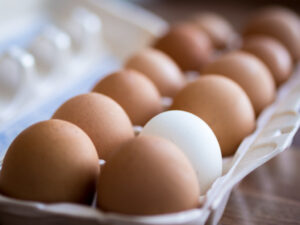
Eggs have many important roles in baking. With heat, the proteins in eggs restructure to solidify the dough. Additionally, egg yolks contain the emulsifier lecithin which combines soluble and insoluble ingredients (like water and fats) to prevent clumping. Lastly, air bubbles formed from whipping eggs provide extra leavening in dough.
Sugar
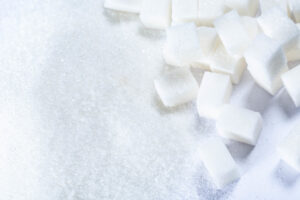
In addition to sweetening desserts and providing food for yeast in bread dough, sugars cause caramelization of baked goods. When heated sugars break down, they release caramel flavor and nutty aromas. Additionally, the characteristic browning of cakes occurs when sugars combine with amino acids released from broken down flour and egg proteins. The chemical reaction between sugars and broken down proteins is called the Maillard reaction. There are hundreds of possible sugar and amino acid combinations that can be made, depending on the exact ingredients and conditions, and each of these unique combinations creates distinct aromas and tastes.
Salt
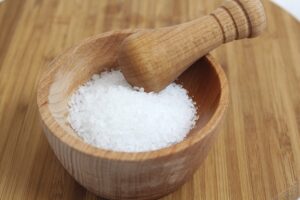
Like sugar, salt has many roles in baking. Salt controls the rate of dough leavening because it draws water out of yeast, which inhibits the yeasts’ ability to ferment sugar and release gas, thus preventing the dough from over rising. Because this process prevents yeast from consuming all of the sugar in the dough, it allows for browned and sweet baked goods. Additionally, ionic interactions between salt and amino acids in proteins allows for tighter gluten strands that can hold gas more efficiently.
Science and baking are inherently intertwined. When we bake, we are chemists combining ingredients that react with each other, and thinking about these chemical reactions can make us better bakers. If you’re interested in learning more about the science behind baking, check out this list of resources or these baking science experiments. Now, ready, set, BAKE!
Peer Editor: Jeanne-Marie McPherson